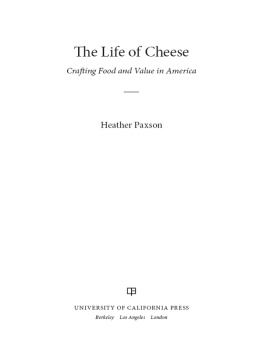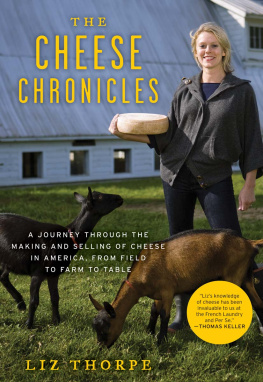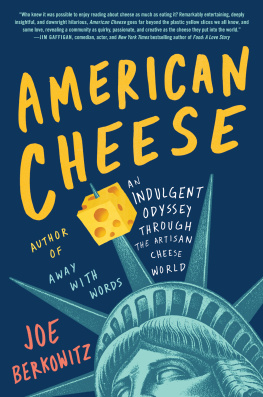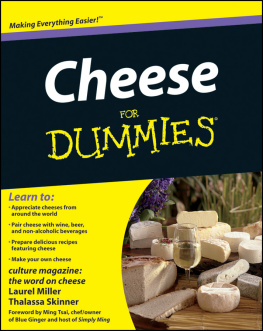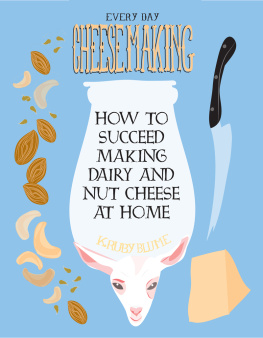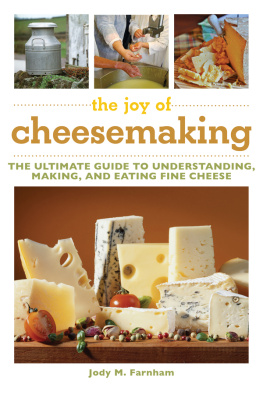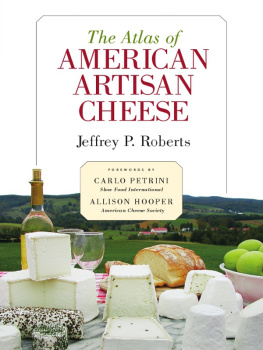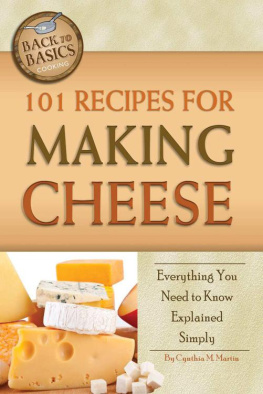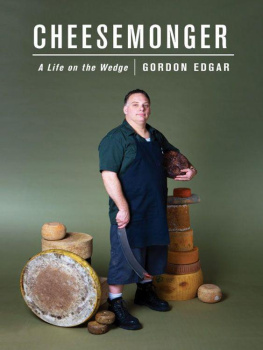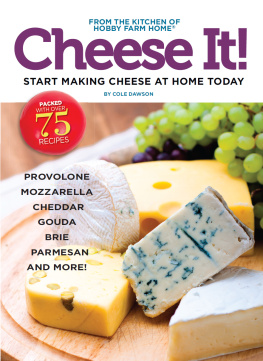
The publisher gratefully acknowledges the generous support of the Humanities Endowment Fund of the University of California Press Foundation.
The Life of Cheese
CALIFORNIA STUDIES IN FOOD AND CULTURE
Darra Goldstein, Editor
The Life of Cheese
Crafting Food and Value in America

Heather Paxson

UNIVERSITY OF CALIFORNIA PRESS
Berkeley Los Angeles London
University of California Press, one of the most distinguished university presses in the United States, enriches lives around the world by advancing scholarship in the humanities, social sciences, and natural sciences. Its activities are supported by the UC Press Foundation and by philanthropic contributions from individuals and institutions. For more information, visit www.ucpress.edu.
University of California Press
Berkeley and Los Angeles, California
University of California Press, Ltd.
London, England
2013 by The Regents of the University of California
Library of Congress Cataloging-in-Publication Data
Paxson, Heather, 1968
The life of cheese : crafting food and value in America / Heather Paxson.
p. cm. (California studies in food and culture ; v. 41)
Includes bibliographical references and index.
ISBN 978-0-520-27017-6 (cloth : alk. paper) ISBN 978-0-520-27018-3 (pbk. : alk. paper)
1. CheesemakingUnited States. 2. Cheese industryUnited States. 3. CheeseSocial aspectsUnited States. 4. Food habitsUnited States. 5. Local foodsUnited States. I. Title.
SF274.U6P39 2013
637'.3dc23
2012026487
Manufactured in the United States of America
22 21 20 19 18 17 16 15 14 13
10 9 8 7 6 5 4 3 2 1
In keeping with a commitment to support environmentally responsible and sustainable printing practices, UC Press has printed this book on Rolland Enviro100, a 100% post-consumer fiber paper that is FSC certified, deinked, processed chlorine-free, and manufactured with renewable biogas energy. It is acid-free and EcoLogo certified.
CONTENTS
ILLUSTRATIONS
FIGURES
TABLES
PREFACE
I love cheese. Growing up in southern Illinois, I considered myself a food snob because I loathed soda and would refuse to touch a sandwich adulterated by a waxy slice of Kraft American. I ate only real cheese, like nicely sharp, not-too-orange Cheddar, or the Baby Swiss my mother bought thinly sliced at the grocers deli counter. When I was fourteen, I chronicled the process of making cheese at the Crowley Cheese Factory in Vermont in a photo-story project for my 4-H club. In my twenties, when I stopped eating meat, cheese became even more central to my diet. But really thinking about cheese came later.
The turning point may have been a millennial summer day in New York City, 2000 or 2001, when a student of my (now) husband stopped by with a paper-bag-wrapped gift whose pungent odor reached clear across the apartment. It was a generous hunk of cheese, slightly squashed from riding in a backpack. Beneath a tacky, almost shockingly orange rind, a toothsome interior was invitingly straw-colored. It tasted not as good as the French poisses we had recently discovered at Murrays Cheese on Bleecker Street. The cheese continued to ripen in our refrigerator, and I think I actually threw out the last bit of it. But I was intrigued. The student had purchased the cheese at the Union Square Greenmarket. This smelly, sticky, decidedly handmade cheese originated within two hundred miles of Manhattan. Who made it? I wondered. How? Why?
Only later, after I had moved to Massachusetts and was plotting the anthropological research behind this book, did I realize that the Greenmarket cheese must have been Hooligan, a washed-rind cheese made at Cato Corner Farm in Colchester, Connecticut, by Mark Gillman. Back in the late 1980s, Mark Gillman and I attended the same liberal-arts college. He did yard work for the woman whose house I cleaned weekly. I was thrilled to be able to purchase Marks cheese (as I now thought of it) from a shop within walking distance of our Cambridge apartment. When not the worse for wear, the cheese is pretty wonderful.
Moving from consumer of cheese to ethnographer of cheesemaking, I visited Mark and many others who are devoted to making a life and a living by making cheese. I came to recognize their vocational project as also a moral project. This book describes what goes into handcrafting cheese, and it analyzes what artisanal work means to the women and men who have chosen to pursue it. As an anthropologist, I am in the business of discerning and interpreting the cultural meanings that both motivate and are conveyed by quotidian aspects of peoples lives. Through manual effort and the rhetorical power of narrative, todays cheesemakers not only craft cheese, they also craft themselves as artisans, entrepreneurs, farmers, and families. In the process, they rework patches of American landscape, transform rural economies, and rewrite the script for American food politics. This book explores the meanings and also the values of artisanal cheese in the United States today.
ACKNOWLEDGMENTS
For introducing me to the life of cheesein all its formsI thank first the cheesemakers, mongers, consultants, scientists, and others I visited and interviewed for this book, including those whose stories did not make it onto the final pages. Early conversations with Ihsan Gurdal and Robert Aguilera of Formaggio Kitchen pointed me to David Major and Cindy Major and to Mateo Kehler and Andy Kehler, who played formative roles in my research. I thank them for their hospitality as well as their insights.
Other members of the artisanal cheese world who contributed in substance and form to this book include Barbara and Rex Backus, Marcia Barinaga, Jill Giacomini Basch, Beatrice Berle, Jennifer Bice, Jim Boyce, Tim Bucciarelli, Joe Burns, Liam and Cindy Callahan, Jeanne Carpenter, Dan Carter, D. J. DAmico, Sasha Davies, Pascal Destendau, Debra Dickerson, Peter Dixon, Catherine Donnelly, Rachel Dutton, Jody Farnham, Gari Fischer, Mark Fischer, Laini Fondiller, Tom Gilbert, Mark Gillman, Mike Gingrich, David Gremmels, Barbara Hanley, Jerry Heimerl, Gail Holmes, Gemma Iannoni, Matt Jennings, Brenda Jensen, Lisa Kaiman, Patty Karlin, Rob Kaufelt, Mary Keehn, Angie Kehler, Paul Kindstedt, Michael Lee, Willi Lehner, Elizabeth MacAlister, Christine Maguire, Quitas McKnight, Angela Miller, Norm Monson, Elizabeth Mulholland, Peter Mulholland, Diana Murphy, Myron Olson, Charlie Parant, Marian Pollack, John Putnam, Marge Randles, Vince Razionale, Jeff Roberts, Matt Rubiner, Judy Schad, Al Scheps, Michael Scheps, David Seaton, Eric Smith, Tricia Smith, Diana Solari, Ann Starbard, Bob Stetson, Marjorie Susman, Dawn Terrell, Anne Topham, Maria Trumpler, Juliana Uruburu, Lori van Handel, Ig Vella, Karen Weinberg, Joe Widmer, Bob Wills, Bruce Workman, and Jon Wright. I am also grateful to the 177 participants in my 2009 survey.
Monty Python reminds us that blessed are the cheesemakers; so too do we cheese scholars feel blessed. My thanks to the Cheese Scholars Collective and especially to Cristina Grasseni, Elia Petridou, Colin Sage, and Harry West for all our collaborative efforts at Schumacher College in Devon, U.K. And to Ken MacDonald for talking, and shopping for, cheese in Toronto.
For organizing conference panels, for inviting me to speak in classrooms and at colloquia, for critically reviewing drafts of this work, for suggesting helpful citations and contacts, and for ongoing conversation, I thank Rebecca Alssid, Tom Boellstorff, Ted Bestor, Rachel Black, Sarah Bowen, Bodil Just Christensen, Jane Collier, George Collier, Carole Counihan, Marcy Dermansky, Kathryn Dudley, Joe Dumit, Jim Faubion, Robin Fleming, Xaq Frolich, M. Amah Edoh, Darra Goldstein, Sherine Hamdy, Deborah Heath, Chaia Heller, Michael Herzfeld, Line Hillersdal, Linda Hogle, Gry Skrdderdal Jakobsen, Chris Kelty, Eben Kirksey, Hannah Landecker, Vincent Lpinay, Victor Luftig, Bill Maurer, Anne Meneley, Natasha Myers, Annemarie Mol, Cris Moore, Kristina Nies, Chris Otter, Canay Ozden, Gsli Plsson, Verena Paravel, Bronwen Percival, Tobias Rees, Juliette Rogers, Sophia Roosth, Russ Rymer, Dorion Sagan, Caterina Scaramelli, Hillel Schwartz, David Sutton, Karen-Sue Taussig, Megan Tracy, Mitali Thakor, Maria Trumpler, Deborah Valenze, Wendy Walker, Charles Watkinson, Corky White, Brad Weiss, Barbara Wheaton, Richard Wilk, Joby Williams, Rebecca Woods, and Ken Wissoker. Susanne Freidberg and Amy Trubek were especially generous and helpful.
Next page
